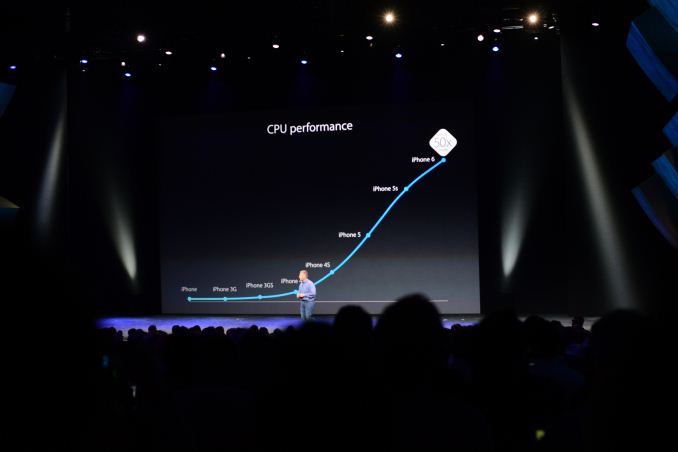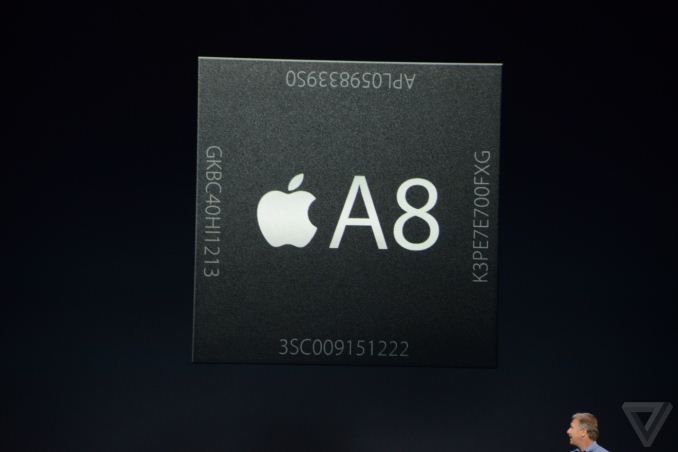Apple Announces A8 SoC
by Ryan Smith on September 9, 2014 1:45 PM EST
As expected from this year’s iPhone keynote, Apple has announced a new member of their internally developed family of ARM SoCs.
The latest SoC, dubbed A8, is Apple’s first SoC built on the 20nm process, and among the first SoCs overall to be built on this process. Apple notes that it has 2 billion transistors and is 13% smaller than the A7, which would give it upwards of twice as many transistors as the A7 and would put the die size at about 89mm2.

Image courtesy The Verge
From a performance perspective Apple is promising 25% faster CPU performance than A7. As is usually the case with Apple, they aren’t talking about the underlying CPU core – though this is a problem we’re working to rectify – so it remains to be seen how much of this is due to CPU architectural upgrades and how much is from clockspeed improvements afforded by the 20nm process. Apple just introduced their 64bit Cyclone core last year, so it stands to reason that just a year later and with the transition to 64bit already completed, A8 packs a CPU that is similar to Cyclone.
| Apple SoC Evolution | |||||
| CPU Perf | GPU Perf | Die Size | Transistors | Process | |
| A5 | ~13x | ~20x | 122m2 | <1B | 45nm |
| A6 | ~26x | ~34x | 97mm2 | <1B | 32nm |
| A7 | 40x | 56x | 102mm2 | >1B | 28nm |
| A8 | 50x | 84x | 89mm2 | ~2B | 20nm |
Meanwhile Apple is being even less specific about the GPU, but from their published baseline performance comparisons against the iPhone 1, the A8 is said to be 84x faster on graphics. This compares to a published figure of 56x for the A7, which implies that the A8’s GPU is 1.5x faster than the A7’s. Given Apple’s conservative stance on clockspeeds for power purposes and the die space gains from the 20nm process, it seems likely that Apple has upgraded from a 4 core PowerVR GPU to a 6 core PowerVR GPU, likely the flagship GX6650, which would account for the 50% performance gain right there.
Finally, Apple notes that the A8 is designed to be 50% more energy efficient than the A7. Some of these efficiency gains would come from gains due the 20nm process, however this large of a gain would indicate that Apple has done additional work at the architectural level to improve efficiency, as smaller manufacturing nodes alone do not see these kinds of gains.
Update: We have posted our initial A8 analysis here










66 Comments
View All Comments
GC2:CS - Tuesday, September 9, 2014 - link
I would say this is rather a tock and pretty big one, but on power efficiency, not performance. Like haswell but better. Look you got 25% better CPU 50% better graphics and all of that for supposedly half the power. This thing pulls so little that hey even pulled off an "sustained performance graph"....OH YEAH like really Apple A8 is not only faster than A7 but it's supposed to not throttle at all in a device that measures 6,9 mm in the thickest point (the camera). That means that after few minutes of Heavy CPU load A7 throttles to 0,9 Ghz and at that time A8 would be about 80% faster AND at lower power as well.
saliti - Tuesday, September 9, 2014 - link
LOL...........GC2:CS - Tuesday, September 9, 2014 - link
Ok ok... Get a bit too excited there... But what's wrong ?Kevin G - Tuesday, September 9, 2014 - link
The real question is what would keep a sustained CPU load for that long in a normal phone usage scenario? The only thing coming to mind would be gaming.jjj - Tuesday, September 9, 2014 - link
"25% smaller than the A7"should be 13% smaller - that's what they said and how we all got to 89mm2.
PICman - Tuesday, September 9, 2014 - link
When somebody shows you a graph for which not all of the axes are labeled, look out - they're lying.darkich - Tuesday, September 9, 2014 - link
The GPU is certainly the GX6650, as revealed by the "sustained performance".Imagination Technologies talked about achieving NO THERMAL THROTTLING in that GPU, on their blog.
The full potential of the A8 SoC will obviously be unleashed in the upcoming iPad.
The amazing efficiency of the SoC should allow for some hefty over clocking, both for the GPU and CPU.
Really looking forward to see that one.
GC2:CS - Wednesday, September 10, 2014 - link
Don't think they will change the A8 in the iPad that much, they will probably focus on battery life. Like A7 brought iPad graphics performance to the iPhone and rather impressive battery life to the iPad thanks to it being build for a low powered phone. I expect the same to happen this year, but you never know.dragonsqrrl - Tuesday, September 9, 2014 - link
Ryan, has there been any word on memory capacity yet?Ryan Smith - Tuesday, September 9, 2014 - link
Nothing we can confirm.